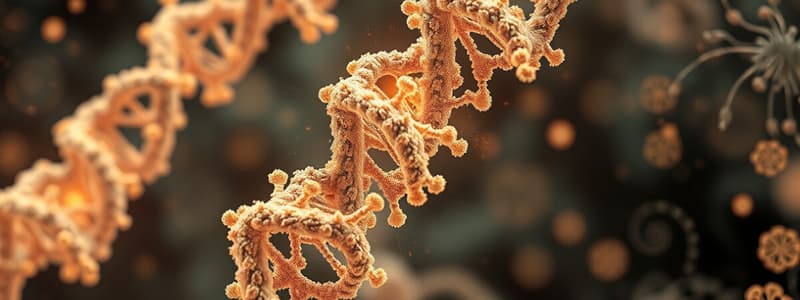Podcast
Questions and Answers
What is the primary role of DNA helicase during DNA replication?
What is the primary role of DNA helicase during DNA replication?
- Unwind and separate the DNA strands. (correct)
- Create RNA primers for synthesis.
- Synthesize new DNA strands.
- Seal nicks in the DNA.
What direction does DNA replication occur in?
What direction does DNA replication occur in?
- 5' to 5'
- 5' to 3' (correct)
- 3' to 5'
- 3' to 3'
Which enzyme is responsible for synthesizing the RNA primer needed for DNA replication?
Which enzyme is responsible for synthesizing the RNA primer needed for DNA replication?
- DNA polymerase
- Helicase
- Primase (correct)
- Ligase
What is the semi-conservative nature of DNA replication?
What is the semi-conservative nature of DNA replication?
What are Okazaki fragments associated with during DNA replication?
What are Okazaki fragments associated with during DNA replication?
Which enzyme is responsible for proofreading and correcting errors during DNA replication?
Which enzyme is responsible for proofreading and correcting errors during DNA replication?
What is the primary function of DNA ligase in DNA replication?
What is the primary function of DNA ligase in DNA replication?
Which component serves as the guide for synthesizing new DNA strands during replication?
Which component serves as the guide for synthesizing new DNA strands during replication?
Study Notes
Molecular Biology: DNA Replication
-
Definition: DNA replication is the biological process of producing two identical replicas of DNA from one original DNA molecule.
-
Key Components:
- DNA Template: The original strand that serves as a guide for replication.
- Nucleotides: The building blocks of DNA, consisting of a sugar, a phosphate group, and a nitrogenous base.
- Enzymes: Essential proteins that facilitate the replication process.
-
Main Enzymes Involved:
- DNA Helicase: Unwinds and separates the two strands of the DNA double helix.
- DNA Polymerase: Synthesizes new DNA strands by adding nucleotides complementary to the template strand.
- Primase: Synthesizes a short RNA primer to provide a starting point for DNA synthesis.
- Ligase: Joins Okazaki fragments on the lagging strand and seals nicks in the DNA.
-
Replication Process:
-
Initiation:
- DNA helicase unwinds the helix, creating replication forks.
- Primase lays down RNA primers on the template strands.
-
Elongation:
- DNA polymerase adds nucleotides to the growing DNA strand, following complementary base pairing rules (A-T, C-G).
- On the leading strand, replication is continuous. On the lagging strand, DNA is synthesized in short segments known as Okazaki fragments.
-
Termination:
- Replication continues until the entire molecule is copied.
- RNA primers are replaced with DNA, and DNA ligase seals gaps between fragments.
-
-
Direction of Replication:
- DNA replication occurs in the 5' to 3' direction, meaning nucleotides can only be added to the 3' end of a growing strand.
-
Semi-conservative Nature:
- Each new DNA molecule consists of one original strand and one newly synthesized strand.
-
Replication Fork:
- The area where the double-stranded DNA is separated into single strands for replication.
-
Proofreading and Repair:
- DNA polymerases have proofreading capabilities to correct errors during replication.
- Mismatches can lead to mutations if not corrected.
-
Eukaryotic vs. Prokaryotic Replication:
- Prokaryotes: Typically have a single circular DNA molecule; replication starts at a single origin and proceeds bidirectionally.
- Eukaryotes: Have multiple linear chromosomes; replication initiates at multiple origins along each chromosome.
-
Significance of DNA Replication:
- Essential for cell division, ensuring genetic information is accurately passed to daughter cells.
- Plays a crucial role in growth, development, and maintenance of all living organisms.
DNA Replication Overview
- DNA replication generates two identical DNA molecules from one original molecule.
- Key to genetic information transmission during cell division.
Key Components
- DNA Template: Original strand guiding the synthesis of new DNA.
- Nucleotides: Composed of a sugar, phosphate group, and nitrogenous base; basic units of DNA.
- Enzymes: Vital proteins that facilitate replication.
Main Enzymes Involved
- DNA Helicase: Unwinds and separates the DNA double helix.
- DNA Polymerase: Synthesizes new strands by incorporating complementary nucleotides.
- Primase: Produces short RNA primers to initiate DNA synthesis.
- Ligase: Connects Okazaki fragments on the lagging strand and seals nicks in the DNA.
Replication Process
- Initiation: Helicase opens the helix, forming replication forks; primase lays down RNA primers.
- Elongation:
- DNA polymerase continuously adds nucleotides to the leading strand.
- Lagging strand synthesized in short segments (Okazaki fragments).
- Termination:
- Completion of the DNA molecule; RNA primers are replaced by DNA.
- DNA ligase links fragments together.
Direction of Replication
- Occurs in a 5' to 3' direction; nucleotides added only to the 3' end of the growing strand.
Semi-conservative Nature
- Each new DNA molecule comprises one original strand and one newly synthesized strand.
Replication Fork
- Region where double-stranded DNA is unwound and separated into single strands for replication.
Proofreading and Repair
- DNA polymerases possess proofreading abilities to correct errors during replication, preventing mutations.
Eukaryotic vs. Prokaryotic Replication
- Prokaryotes: Single circular DNA; replication begins at a single origin and proceeds bidirectionally.
- Eukaryotes: Multiple linear chromosomes; replication initiates at multiple origins on each chromosome.
Significance of DNA Replication
- Critical for accurate transmission of genetic information during cell division.
- Essential for the growth, development, and maintenance of all living organisms.
Studying That Suits You
Use AI to generate personalized quizzes and flashcards to suit your learning preferences.
Description
Test your understanding of DNA replication, a crucial biological process where a DNA molecule is copied to produce identical replicas. This quiz covers the key components, main enzymes involved, and the replication process steps. Get ready to enhance your molecular biology knowledge!



